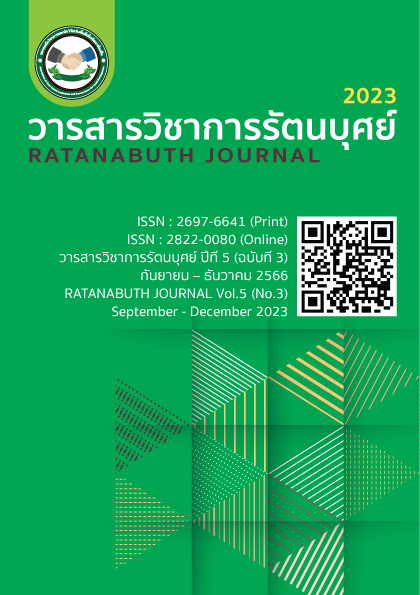A Model of Ethical Leadership Development of School Administrators Under The Secondary Educational Service Area Office Kalasin A Model of Ethical Leadership Development of School Administrators Under The Secondary Educational Service Area Office Kalasin
Main Article Content
Abstract
The purposes of this research were 1) to study the components and indicators of ethical leadership of school administrators. 2) to study the current situation, desirable condition and priority needs of ethical leadership of school administrators under the secondary educational service area office Kalasin. 3) create a model for developing ethical leadership of school administrators under the secondary educational service area office Kalasin. 4) to study the results of using the ethical leadership development model of school administrators under the secondary educational service area office Kalasin. The research was divided into 4 phases: Phase 1: studied components and indicators. The target group is 9 experts to confirm the components and indicators. Phase 2: studied the current situation, desirable condition and priority needs of ethical leadership of school administrators. The sample group consisted of 322 school administrators and teachers. The research tool was a questionnaire. The statistics used in this study were descriptive statistics is frequency, percentage, mean, and standard deviation. Phase 3: create a model. The target group is 9 experts to confirm and assess propriety, feasibility and utility of the model. Phase 4: studied the results of the model. The target groups were school administrators under the secondary educational service area office Kalasin.
The research results found that ; 1) The components and indicators of ethical leadership of school administrators consisted of honesty, justice, respect and respect for others, and responsibility. 2)The overall current condition is at a high average level. The overall desirable condition was at the highest mean level. 3) The model consists of elements: principles, objectives, content, development process, measurement and evaluation. There are 4 modules of learning. The model has a propriety assessment result. possibility and the overall utility of the model was at the highest level. 4) Results of the study using the model overall, the indicators were followed at the highest level. The results of the satisfaction assessment toward the overall use of the model, satisfaction was at the highest level.
Article Details

This work is licensed under a Creative Commons Attribution-NonCommercial-NoDerivatives 4.0 International License.
References
กระทรวงศึกษาธิการ. (2550). แนวทางปฏิรูปการศึกษาของกระทรวงศึกษาธิการ. กรุงเทพฯ: ที.เอส.บี. โปรดักส์.
ชุติมา รักษ์บางแหลม, เอกรินทร์ สังข์ทอง, ชวลิต เกิดทิพย์ และชิดชนก เชิงเชาวน์. (2559). ภาวะผู้นำเชิงจริยธรรม: หนทางสู่การขับเคลื่อนภาวะผู้นำในสถาบันศึกษา. วารสารมหาวิทยาลัยนราธิวาสราชนครินทร์, 8 (1), 168-180.
ชัยเสฏฐ พรหมศรี. (2557). ภาวะผู้นําร่วมสมัย. กรุงเทพฯ : ปัญญาชน.
ธีระ รุญเจริญ. (2562). ทิศทางการจัดการเรียนรู้สู่การศึกษา 4.0 ในยุคดิจิทัล. รวมบทความการบริหารการศึกษากับการพัฒนาการจัดการเรียนรู้ สู่การศึกษาในยุคดิจิทัล ชุดที่ 1. อุบลราชธานี: วิทยาการพิมพ์ 1973.
บุญชม ศรีสะอาด. (2556). การวิจัยเบื้องต้น (ฉบับปรับปรุงใหม่). (พิมพ์ครั้งที่ 9). กรุงเทพฯ : สุวีริยาสาส์น.
ประชุม โพธิกุล. (2550). ความกล้าทางจริยธรรมของผู้นำทางการศึกษา. กรุงเทพฯ: สถาบันพัฒนาผู้บริหารการศึกษา กระทรวงศึกษาธิการ.
รัตติกรณ์ จงวิศาล. (2559). ภาวะผู้นำ ทฤษฎี การวิจัยและแนวทางสู่การพัฒนา. (พิมพ์ครั้งที่ 3). กรุงเทพฯ: สำนักพิมพ์แห่งจุฬาลงกรณ์มหาวิยาลัย.
รัตนวดี โชติกพนิช. (2554). จริยธรรมและจรรยาบรรณในวิชาชพีครู Moral and Ethics in Teaching Profession CU 503. Di6. กรุงเทพฯ : ภาควิชาหลักสูตรและการสอน คณะศึกษาศาสตร์ มหาวิทยาลัยรามคําแหง.
สมาน อัศวภูมิ. (2550). การใช้วิจัยพัฒนารูปแบบในวิทยานิพนธ์ระดับปริญญาเอก. เอกสารประกอบการสอนวิชาสัมมนาการศึกษาระดับปริญญาเอก. อุบลราชธานี: มหาวิทยาลัยราชภัฏอุบลราชธานี.
สิน งามประโคน. (2563). ภาวะผู้นำเชิงพุทธของผู้บริหารในยุคชีวิตวิถีใหม่. กรุงเทพฯ : คณะครุศาสตร์ มหาวิทยาลัยมหาจุฬาลงกรณราชวิทยาลัย.
สิริกร ไชยราช. (2562). การพัฒนารูปแบบการพัฒนาภาวะผู้นำครูในการจัดการเรียนรู้ตามหลักปรัชญาของเศรษฐกิจพอเพียง ในโรงเรียนมัธยมศึกษา สังกัดสำนักงานศึกษาธิการภาค 11. วิทยานิพนธ์ครุศาสตรดุษฎีบัณฑิต.สกลนคร: มหาวิทยาลัยราชภัฏสกลนคร.
สำนักงานเลขาธิการสภาการศึกษา. (2564). รายงานการศึกษาการพัฒนาคุณภาพผู้เรียนจากผลการทดสอบ O-NET และ PISA. กรุงเทพฯ: สำนักงานเลขาธิการสภาการศึกษา.
สุวิมล ว่องวาณิช. (2558). การวิจัยประเมินความต้องการจำเป็น. กรุงเทพฯ: สำนักพิมพ์แห่งจุฬาลงกรณ์มหาวิทยาลัย.
หงษา วงค์จำปา. (2560). รูปแบบการพัฒนาภาวะผู้นำเชิงจริยธรรมของผู้บริหารสถานศึกษา สังกัดสำนักงานคณะกรรมการการศึกษาขั้นพื้นฐานในภาคตะวันออกเฉียงเหนือ. วิทยานิพนธ์ปรัชญาดุษฎีบัณฑิต.สกลนคร: มหาวิทยาลัยราชภัฏสกลนคร.
Anderson, T. P. (1997). Using Models of Instruction. In C. R. Dills and A. J. Romiszowski (eds). Instructional Development Paradigms. Englewood Cliffs, NJ: Educational Technology Publications.
Daft, R.L. (2008). The Leadership Experience. (4th ed). Mason, OH: Thomson South- Western.
Eisner, E. (1976). Education connoisseurship and criticism: Their form and function in education evaluation. Journal of Aesthetic Education, 10(3),135-150.
Joyce, B. and Weil, M. and B. Showers. (2011). Models of Teaching. Boston: Allyn and Bacon.
Krejcie, R. V. & Morgan, D. W. (1970). Determining Sample Size for Research Activities. Educational and Psychological Measurement.
Northouse, Peter G. (2001). Leadership : Theory and Practice. (2nded). California: Sage Publications.
Northhouse, P. G. (2007). Leadership : Theory and Practice. (4th edition). Thousand Oaks, California : Sage Publications.


